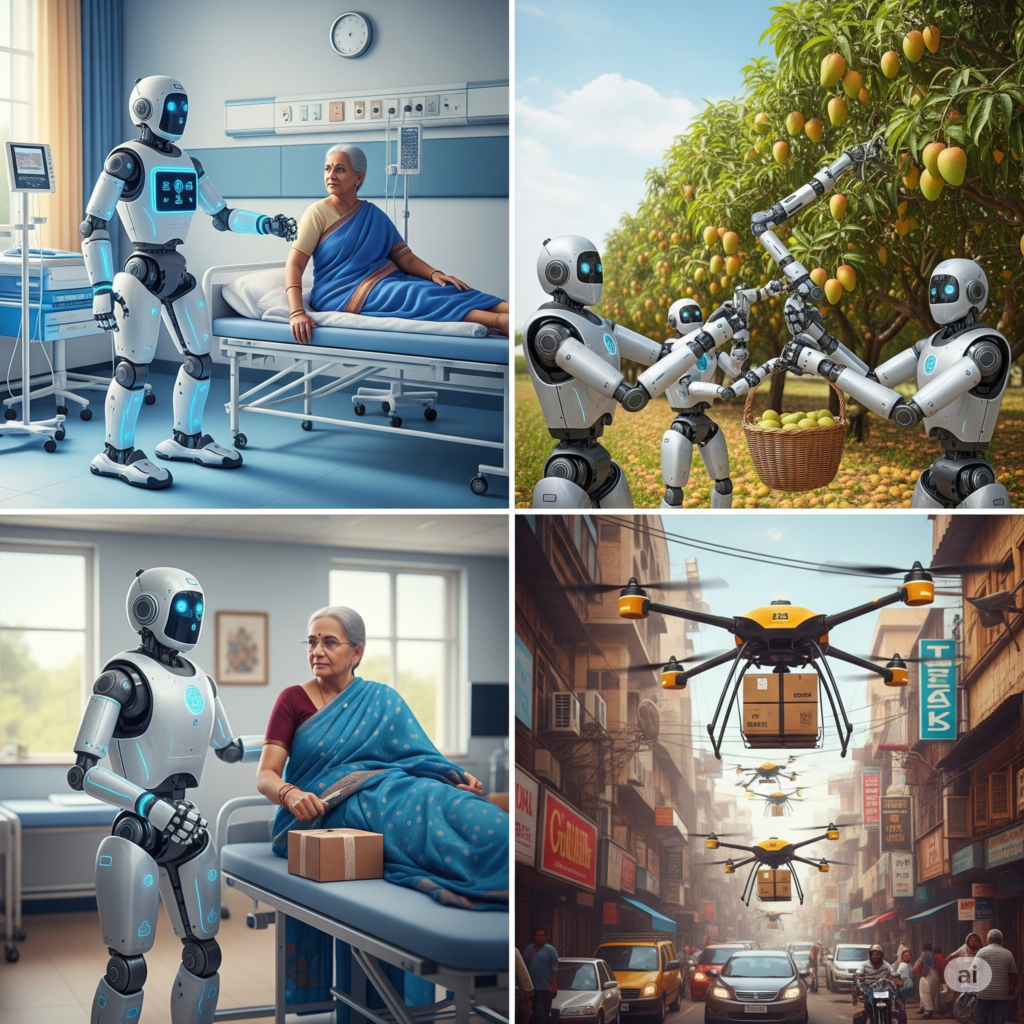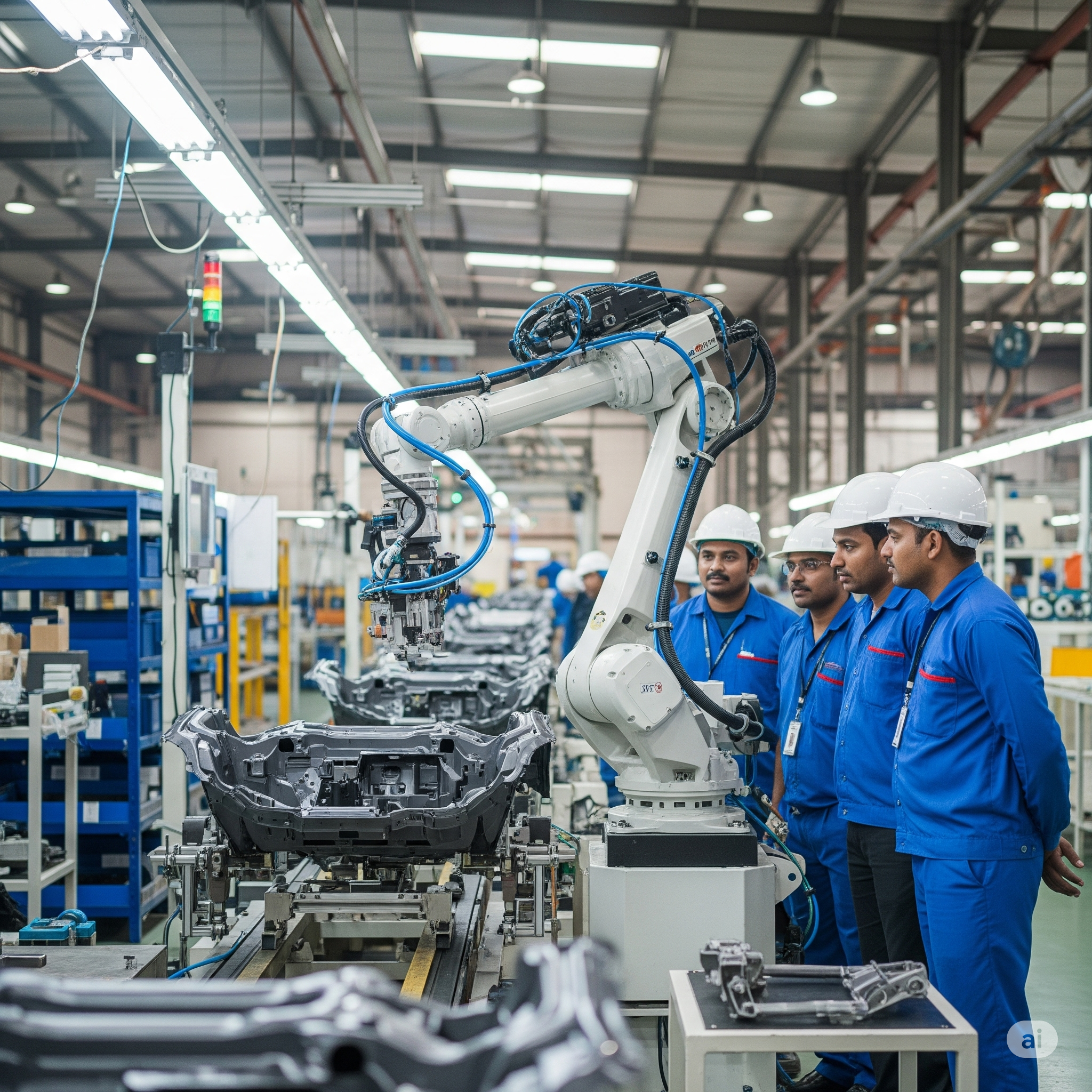In-short:
- India is rapidly emerging as one of the world’s top 10 markets for industrial robot installations.
- Growth is driven by sectors such as automotive, electronics, and manufacturing modernization.
- Adoption of robotics is crucial for India’s “Make in India” initiative and to boost manufacturing productivity.
- Challenges include high initial costs, skills shortage, and infrastructure gaps.
- The future holds promise with government support, increased automation awareness, and local innovation.
- This blog explores the factors behind India’s rise, industry impacts, challenges, and what it means for the workforce and economy.
Introduction
The world is witnessing a transformative wave of automation, with robots becoming essential players in manufacturing and other industries. India, known for its vast workforce and burgeoning economy, is increasingly embracing this robotic revolution. Once considered a technology reserved for developed economies, industrial robots are now steadily finding their place in Indian factories and assembly lines.
Recently, India climbed into the ranks of the top 10 countries in terms of industrial robot installations, joining giants like China, the United States, Japan, and Germany. This surge signals a significant shift in India’s industrial landscape, promising to reshape manufacturing processes, boost productivity, and enhance global competitiveness.
But what exactly is driving this growth? What sectors are benefiting the most? And how will India manage the challenges associated with automation? In this blog, we will analyze India’s rise as a robotic powerhouse, explore the current trends, examine the challenges, and consider what this means for the future of work and economic growth.
The Global Context: Industrial Robots and Automation
What Are Industrial Robots?
Industrial robots are programmable machines designed to perform repetitive tasks with high precision and speed, often in manufacturing environments. They include robotic arms, automated guided vehicles (AGVs), and collaborative robots (cobots) that work alongside humans.
Why Are Robots Critical Globally?
Globally, industries are turning to robots for various reasons:
- Increased productivity: Robots can work 24/7 without fatigue.
- Precision and quality: Robots reduce errors and improve product consistency.
- Safety: Robots perform hazardous tasks, reducing workplace accidents.
- Cost savings: Over time, automation reduces labor and operational costs.
The global industrial robot market was valued at over $50 billion in recent years and is projected to grow steadily due to the ongoing Industry 4.0 revolution.
India’s Journey: Entering the Top 10 Robot Installation Markets
Recent Growth Statistics
According to the International Federation of Robotics (IFR), India ranked among the top 10 countries worldwide for robot installations in recent years, marking a milestone in the country’s industrial automation journey. The compound annual growth rate (CAGR) for robot installations in India has been impressive, often exceeding 20% in recent years.
Driving Forces Behind India’s Robot Adoption
Several factors contribute to India’s growing robot installations:
- Make in India Initiative:
Launched in 2014, this flagship government program aims to transform India into a global manufacturing hub. Automation and robotics are key to achieving enhanced productivity and quality. - Rising Labor Costs and Scarcity:
While India has a large workforce, labor costs in some sectors are rising, and skilled labor shortages are impacting efficiency. Robots help bridge this gap. - Sectoral Demand:
The automotive sector, electronics manufacturing, and consumer goods production have been leading adopters, requiring precision and speed. - Technological Advancements:
Availability of more affordable robots, including collaborative robots (cobots), is enabling small and medium enterprises (SMEs) to adopt automation. - Government Policies and Incentives:
Policy reforms supporting Industry 4.0 technologies and subsidies for automation have accelerated adoption.
Sector-wise Analysis: Where Robots Are Making the Biggest Impact
Automotive Industry
The automotive sector has been the biggest driver of robotics in India. Major car manufacturers like Maruti Suzuki, Tata Motors, and Mahindra have integrated robots for welding, painting, assembly, and quality control. Robotics improve production efficiency, reduce errors, and allow faster turnaround times.
Electronics and Consumer Goods
India’s growing electronics manufacturing industry, including mobile phone production hubs in places like Noida and Hyderabad, benefits from robotic automation to meet global quality standards and mass production needs.
Pharmaceuticals and Food Processing
Although slower to adopt robots, the pharmaceutical and food processing sectors are beginning to incorporate automation for packaging, sorting, and quality inspection.
Small and Medium Enterprises (SMEs)
Traditionally, SMEs have lagged behind in adopting robotics due to high costs and lack of awareness. However, affordable and user-friendly cobots are starting to democratize automation access for smaller businesses, helping them stay competitive.
Benefits of Robotics Adoption in India
Boosting Manufacturing Productivity
Robots enable faster production cycles with minimal downtime, helping Indian manufacturers meet domestic and export demand efficiently.
Improving Product Quality and Consistency
Robotics reduces human errors and defects, which is essential for sectors aiming at export quality standards.
Enhancing Worker Safety
Automation handles hazardous and strenuous tasks, reducing occupational injuries.
Supporting Skill Development and Innovation
While robots replace some manual jobs, they also create demand for skilled technicians and engineers, promoting higher education and innovation.
Challenges Hindering Faster Robot Adoption
High Initial Investment Costs
Robots require significant upfront capital, which is a hurdle for many companies, especially SMEs.
Skills Gap and Workforce Training
There is a shortage of professionals skilled in robotics programming, maintenance, and integration. India needs focused vocational training and education reforms.
Infrastructure and Ecosystem Limitations
Lack of adequate industrial infrastructure and supply chain ecosystems limits efficient robot deployment in many regions.
Concerns Over Job Displacement
Automation sparks fears of job losses in a country with millions depending on manufacturing jobs, necessitating careful policy planning.
Government Initiatives and Support
Policy Frameworks Encouraging Automation
India’s policies like the National Policy on Electronics and the Production Linked Incentive (PLI) scheme support robotics and Industry 4.0 technologies.
Skill India and Training Programs
Government programs aim to reskill workers, ensuring they can manage and collaborate with robots rather than be displaced.
Public-Private Partnerships
Collaborations between the government, educational institutes, and private companies aim to build robotics research centers and innovation hubs.
The Road Ahead: India’s Robotics Future

Increasing Localization and R&D
India is pushing for more homegrown robotics technology, reducing dependence on imports and fostering innovation.
Integration with Emerging Technologies
Combining robotics with AI, IoT, and machine learning will enable smarter, adaptive automation systems.
Expanding Beyond Manufacturing
Robots are expected to enter healthcare, agriculture, logistics, and services sectors, broadening their impact.
Balancing Automation and Employment
Sustainable growth will require balancing automation with human employment through upskilling and social policies.
Conclusion: Embracing the Robotic Revolution with Caution and Vision
India’s emergence as a top 10 global market for industrial robot installations reflects its accelerating commitment to modernization and competitiveness. Robotics promise higher productivity, better quality, and safer workplaces — essential for India’s aspirations to become a global manufacturing leader.
Yet, the journey must be balanced with a pragmatic approach to workforce development, affordable access, and ecosystem readiness. By fostering innovation, investing in skills, and carefully managing socio-economic impacts, India can harness robotics not as a threat but as a powerful tool for inclusive growth and global leadership in the new industrial era.









+ There are no comments
Add yours